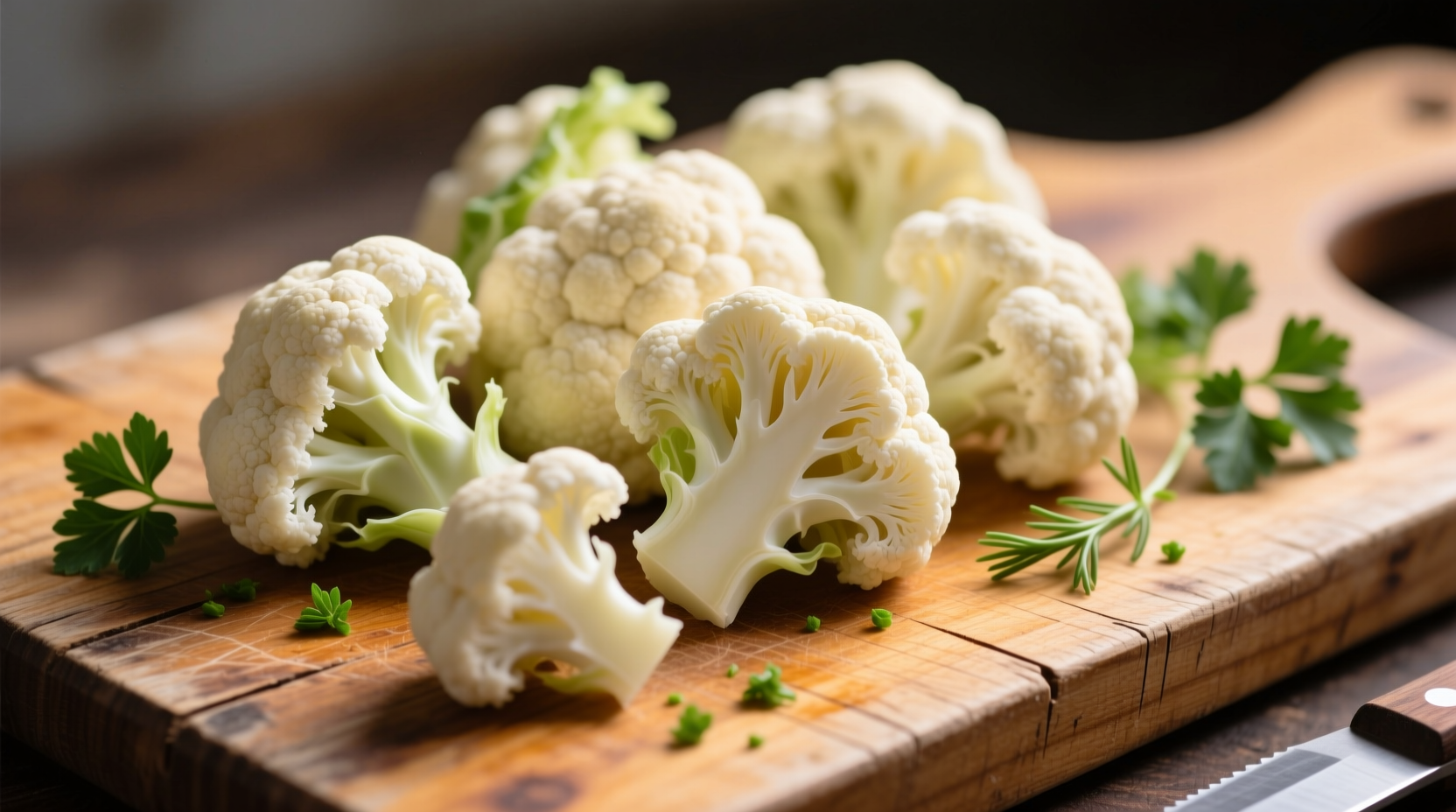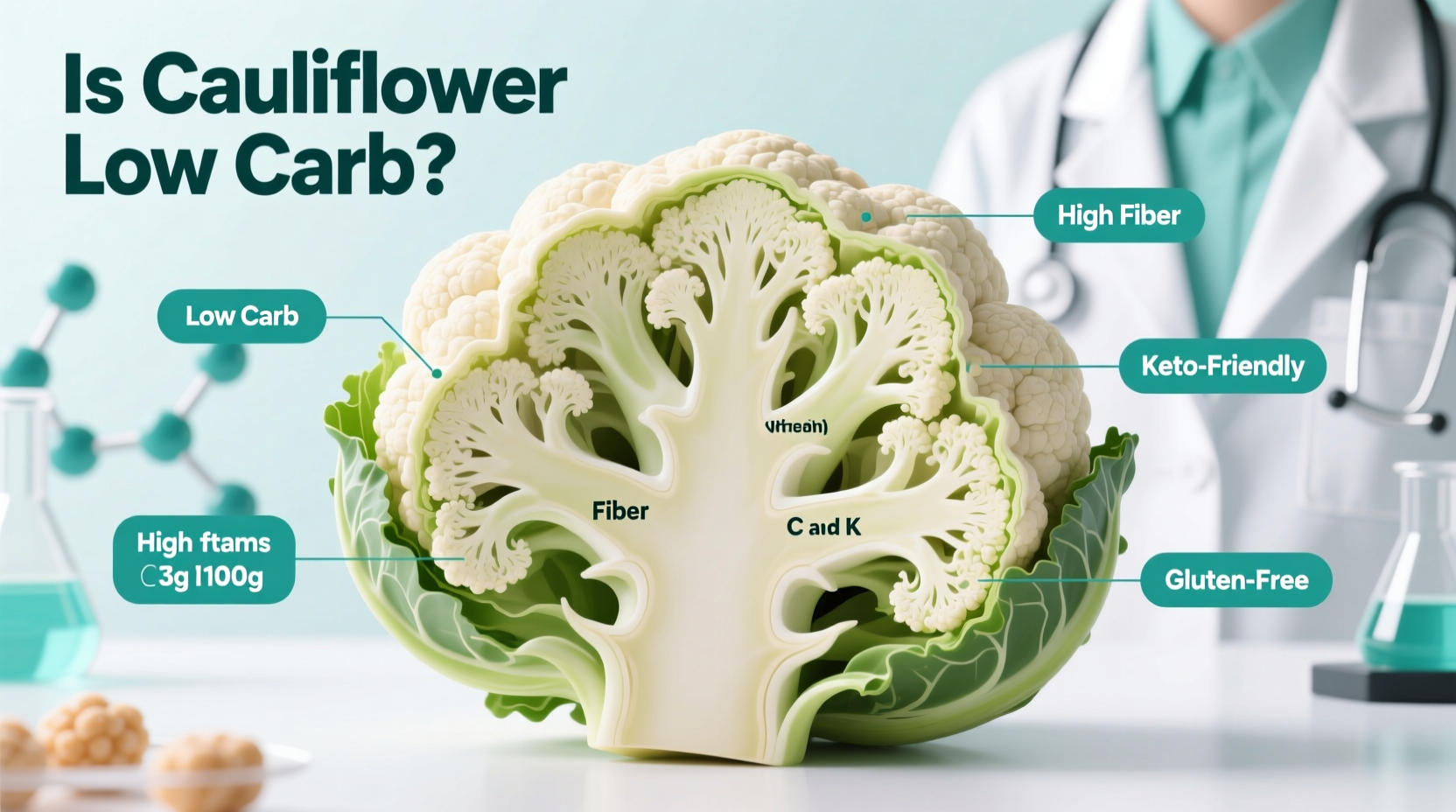Yes, cauliflower is low carb with just 2.8 grams of net carbs per 100 grams, making it an excellent choice for keto, paleo, and other low-carb diets. This versatile vegetable contains 74% water, 2 grams of fiber, and only 5 grams of total carbohydrates per 100g serving.
When you're navigating low-carb eating, finding vegetables that won't derail your progress is crucial. Cauliflower has earned its reputation as a superstar in low-carb cooking circles for good reason. Unlike starchy vegetables that can quickly exceed your daily carb limit, cauliflower delivers maximum versatility with minimal carbohydrate impact.
Why Cauliflower Works for Low-Carb Diets
Understanding why cauliflower qualifies as low carb requires examining both its nutritional composition and how it compares to alternatives. The key metric for low-carb dieters is net carbs (total carbs minus fiber), as fiber doesn't significantly impact blood sugar.
Cauliflower shines with its impressive nutritional profile. According to USDA FoodData Central, a 100-gram serving (about 3/4 cup of florets) contains:
| Nutrient | Amount per 100g | % Daily Value |
|---|---|---|
| Total Carbohydrates | 5.0 g | 2% |
| Dietary Fiber | 2.0 g | 7% |
| Net Carbs | 3.0 g | - |
| Protein | 1.9 g | 4% |
| Fat | 0.3 g | 0% |
| Calories | 25 | 1% |
This nutritional profile makes cauliflower significantly lower in carbs than many common vegetables. For context, consider how it compares to alternatives you might use in similar recipes:
| Vegetable (100g) | Total Carbs | Fiber | Net Carbs |
|---|---|---|---|
| Cauliflower | 5.0 g | 2.0 g | 3.0 g |
| Broccoli | 7.2 g | 2.6 g | 4.6 g |
| Carrots | 9.6 g | 2.8 g | 6.8 g |
| Peas | 14.5 g | 5.1 g | 9.4 g |
| White Potatoes | 17.0 g | 2.2 g | 14.8 g |
How Cauliflower Fits Into Different Low-Carb Eating Plans
The acceptable carb range varies depending on your specific dietary approach. Here's how cauliflower performs across popular low-carb protocols:
- Ketogenic diets typically limit net carbs to 20-50g daily. A full cup of cauliflower rice (about 100g) uses only 3g of your precious carb allowance.
- Standard low-carb diets might allow 50-100g net carbs daily, where cauliflower provides flexibility for other carb sources.
- Diabetes management often focuses on consistent carb intake, where cauliflower's low impact helps maintain stable blood sugar.
Research published in the American Journal of Clinical Nutrition confirms that non-starchy vegetables like cauliflower contribute minimally to glycemic load, making them ideal for blood sugar management. The high fiber content also promotes satiety, helping with portion control without sacrificing volume in meals.

Practical Ways to Use Cauliflower in Low-Carb Eating
What makes cauliflower truly valuable isn't just its nutritional profile but its culinary versatility. Unlike many low-carb vegetables, cauliflower can mimic higher-carb foods through simple preparation techniques:
Cauliflower Rice
Pulsing fresh cauliflower in a food processor creates perfect rice substitute with just 3g net carbs per cup compared to 45g in white rice. For best results, sauté with a little oil until tender-crisp—overcooking creates excess moisture.
Cauliflower Mash
Boil florets until tender, then blend with garlic, butter, and cream for a mashed potato alternative containing 75% fewer carbs. This satisfies the craving without the blood sugar spike.
Pizza Crust and Baking Applications
When making cauliflower pizza crust, remember that moisture control is critical. After ricing and cooking, squeeze out excess water thoroughly. A typical 6-inch cauliflower crust contains about 8g net carbs versus 30g+ in traditional crust.
Important Considerations for Low-Carb Success
While cauliflower is undoubtedly low carb, several factors affect how it fits into your specific dietary needs:
- Portion awareness: Even low-carb foods can add up. Stick to recommended serving sizes, especially when using multiple cauliflower-based substitutes in one meal.
- Preparation methods: Store-bought cauliflower rice often contains more moisture (and thus slightly more carbs by volume) than homemade. Pre-riced options may also include additives.
- Individual tolerance: Some people following very strict ketogenic protocols (under 20g net carbs daily) may need to carefully track even cauliflower consumption.
- Nutrient density: While low in carbs, cauliflower provides vitamin C, vitamin K, and choline—nutrients often lacking in restrictive diets.
A 2023 review in Nutrition Reviews highlighted that successful long-term low-carb dieters prioritize nutrient-dense, whole food sources like cauliflower rather than relying solely on processed low-carb products. This approach maintains nutritional adequacy while achieving carb goals.
When Cauliflower Might Not Fit Your Low-Carb Plan
Despite its advantages, cauliflower isn't appropriate for every low-carb situation:
- Very strict therapeutic ketogenic diets (under 15g net carbs daily) may require careful carb budgeting where even cauliflower portions need limitation.
- Certain digestive conditions like IBS may make cauliflower problematic due to its FODMAP content, despite low carb count.
- Raw versus cooked: Raw cauliflower contains slightly more carbs per volume than cooked (due to water loss), which matters for precision tracking.
For those with specific medical conditions requiring carb restriction, consulting a registered dietitian ensures your vegetable choices align with your health goals. The Academy of Nutrition and Dietetics emphasizes personalized approaches to carbohydrate management rather than one-size-fits-all recommendations.
Maximizing Cauliflower's Low-Carb Benefits
To get the most from cauliflower in your low-carb journey:
- Always measure portions before cooking, as volume changes significantly when riced or mashed
- Pair with healthy fats like olive oil or avocado to enhance nutrient absorption
- Season aggressively with herbs and spices to compensate for milder flavor than starchy alternatives
- Consider growing your own if possible—freshly harvested cauliflower has optimal texture and flavor
Remember that variety remains important even on low-carb diets. Rotate cauliflower with other low-carb vegetables like broccoli, zucchini, and leafy greens to ensure broad nutrient intake. The Dietary Guidelines for Americans 2020-2025 emphasize vegetable diversity as key to nutritional adequacy, even within dietary restrictions.











 浙公网安备
33010002000092号
浙公网安备
33010002000092号 浙B2-20120091-4
浙B2-20120091-4